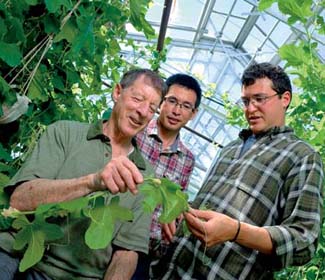 |
 |
| current issue |  |
past issues |  |
send a letter/news |  |
address update |  |
advertise |  |
about us |  |
alumni home |
Features
The MatchmakerPage 3 of 4
From the first of June on, most of the action moves to Kingman Farm. After extracting seeds from the most promising F1 fruits bred in the greenhouse, Loy and his students transfer the seedlings outdoors for his hybrid trials. Following a precise planting plan, they mark 5 acres of different hybrids—pumpkins and squashes, gourds and cantaloupes—with different colored flags. Loy puts in upwards of 12 hours a day in the summer heat, weeding and watering, monitoring the soil, spraying for beetles and mites, and warding off crows. By August, his acres are a sea of dark green leaves, yellow flowers and early fruit.
To the untrained eye, Loy's crops look flawless—endless rows of robust pumpkins and melons the likes of which the average backyard gardener only dreams of growing. But every summer Loy discards fully half of his trial yields, eliminating fruit for such negligible flaws as a protruding stigma or a displeasingly large blossom scar. The half that make the cut will be taken to the lab to be weighed and analyzed for nutritional content, percentage of fruit (the pulp, minus the water) and sugar. Seeds from the most promising fruits may be put aside to be used for another round of breeding. It can take more than four or five breeding trials—and as many years—to come up with the perfect matrix of traits.
Loy is pleased with his efforts to create a number of cantaloupe hybrids that have high sugar content, delayed ripening and a long shelf life. He's also created several varieties that are fast-ripening (32 days from fruit set, compared to an industry average of 45) and high in sugar (16.5 percent soluble solids versus an industry average of 11). The key to his perfect melon will be to combine just the right delayed-ripening, long-shelf-life line with the right fast-ripening, high-sugar line. He's close, he thinks, but he hasn't quite gotten it yet.
 Lisa Nugent/UNH Photographic Services
Lisa Nugent/UNH Photographic ServicesGREENHOUSE EFFECT: Loy, left, Hua Cui '05G, '09G and Jake Uretsky '12G. |
"Melons are a huge challenge, because there are literally dozens of different traits that you're selecting for," Loy says. The challenge is one reason melons are his favorite crop to grow, and his eyes fairly dance at the thought of creating the ultimate cantaloupe. "But, boy, do I really feel like I'm onto something right now."
The prospects for his cantaloupe notwithstanding, Loy is well aware that perfection and success in the market do not always go hand in hand. In the late 1990s, after two decades of pumpkin breeding work, he embarked on an effort to produce a pumpkin with commercial-quality hull-less seeds. Patiently crossing line upon line of pumpkins with large seeds, high seed yield and disease resistance, Loy envisioned a snack seed that would emerge from the pumpkin virtually ready to eat, loaded with protein and potassium and more flavorful than the ever-popular sunflower seed. The Snackjack hybridization was successful, and the seeds received rave reviews in taste tests, but to Loy's dismay, he soon discovered the U.S. market for his new creation was all but nil.
"I still couldn't tell you why," he says, mystified. "The seeds are delicious and they're healthy, with no cholesterol. And the pumpkin flesh itself is pie quality."
Another disappointment for Loy has been his inability to bring his immensely popular Thunder kabocha squash to the Japanese growers' market. Loy says Thunder is better than the product currently available in Japan (imported from New Zealand to the tune of $100 million a year) on virtually every dimension—quality, yield, color and flavor—but Japanese growers aren't allowed to grow it.
Page: 1 2 3 4 Next >
Easy to print version
blog comments powered by Disqus

